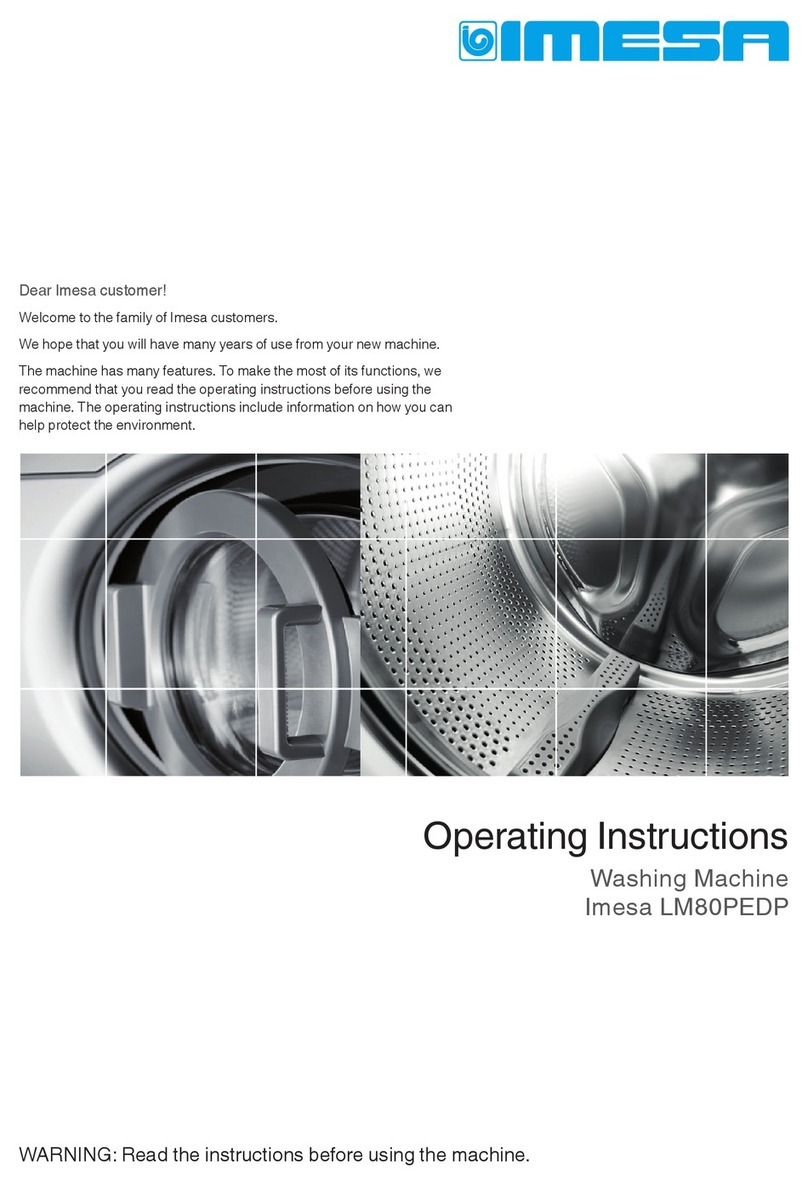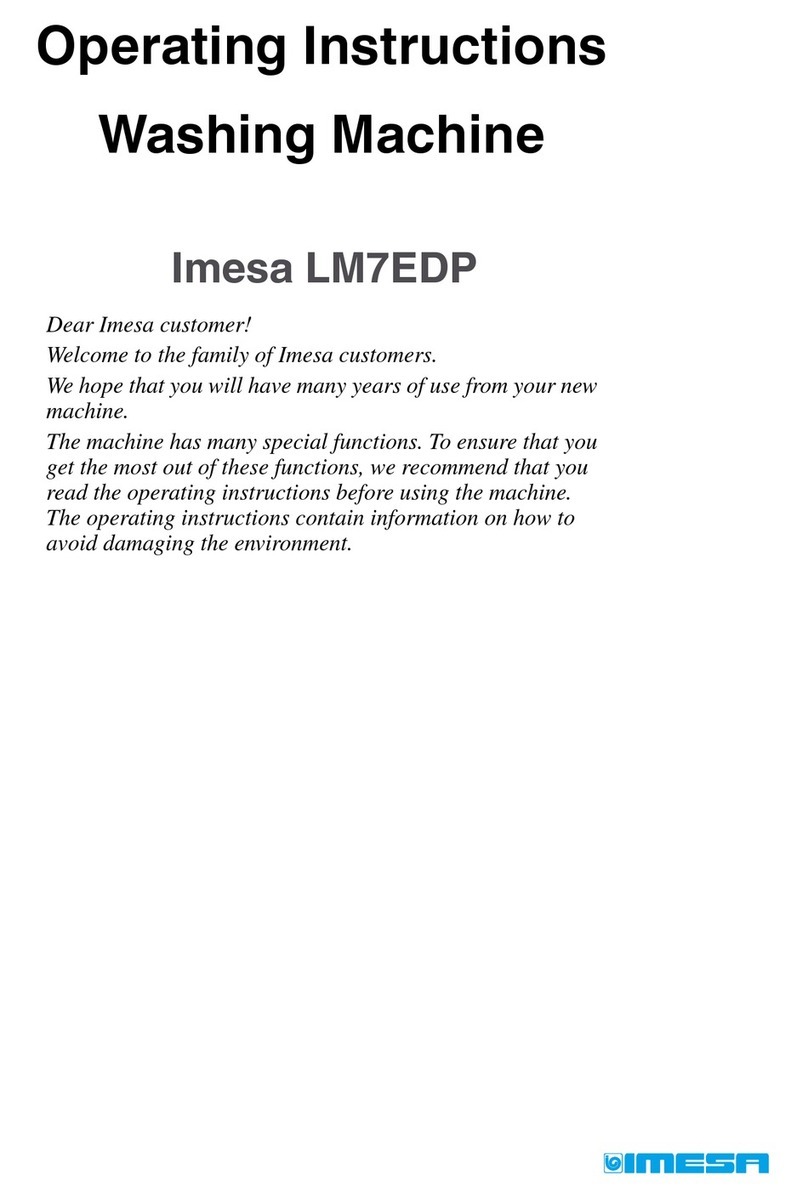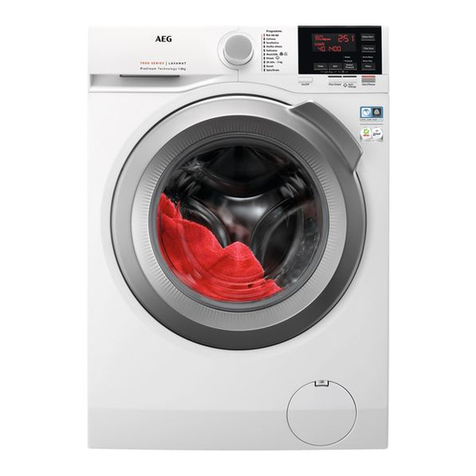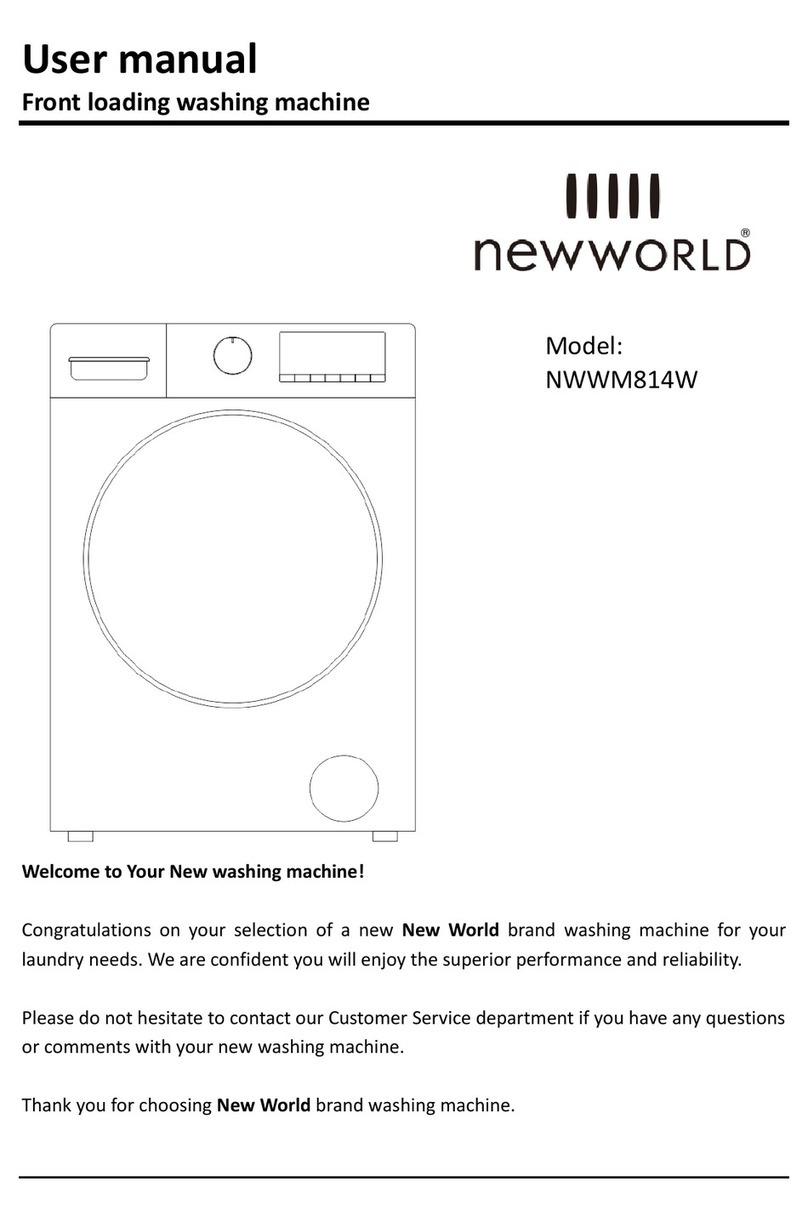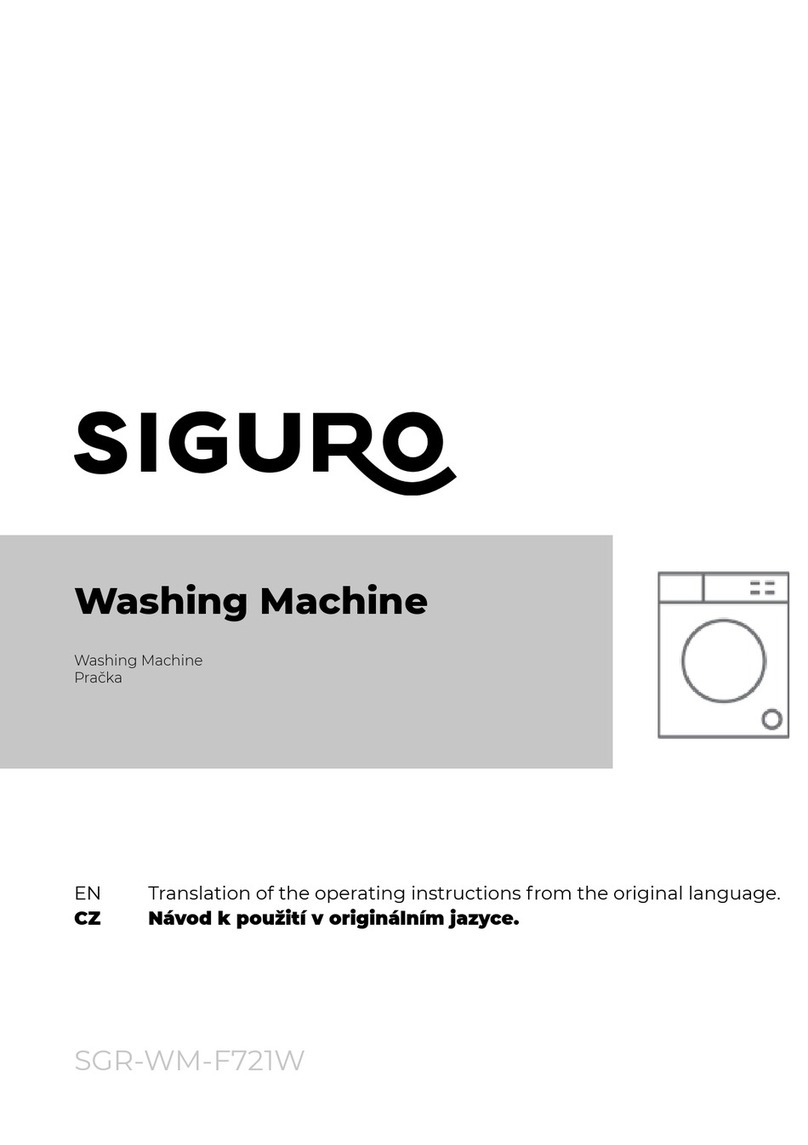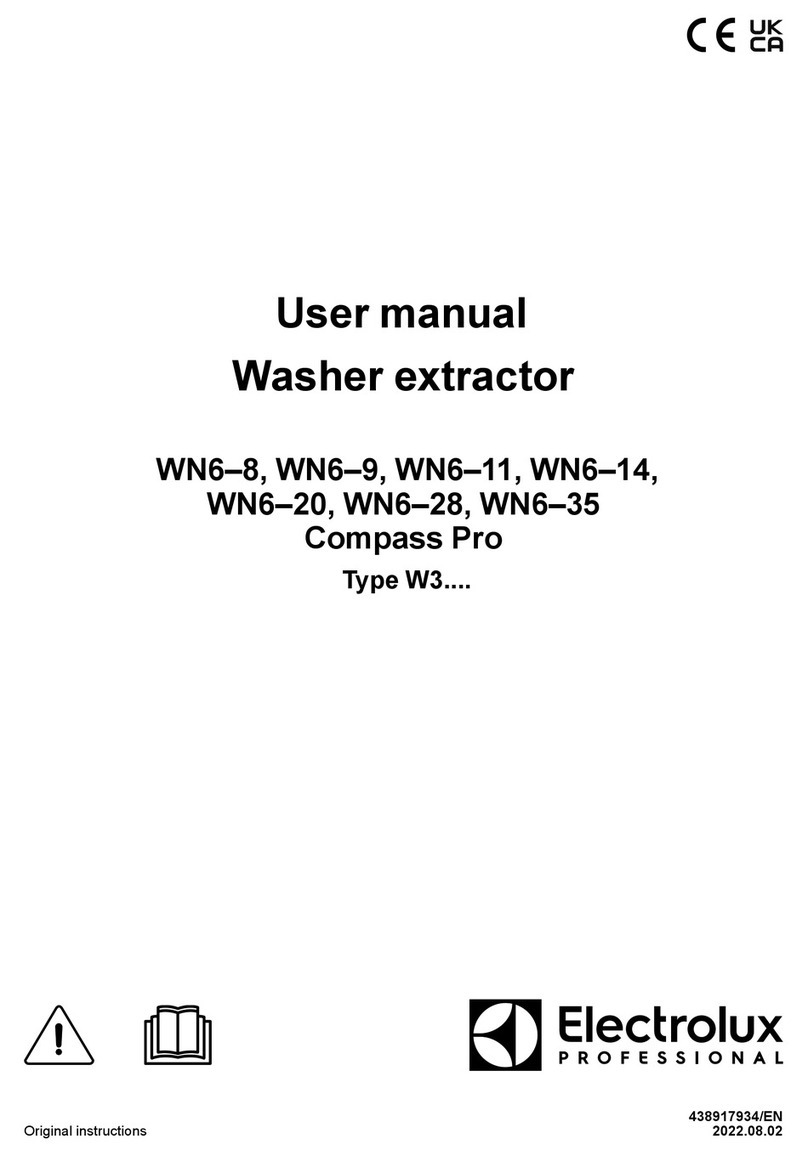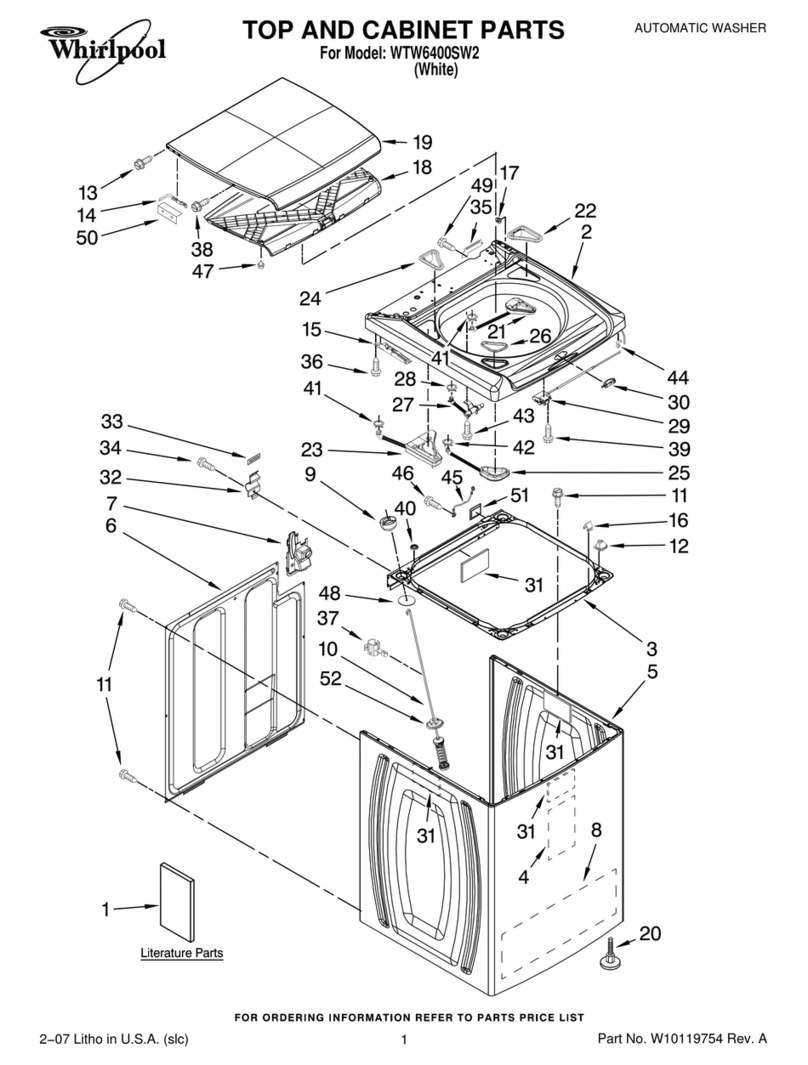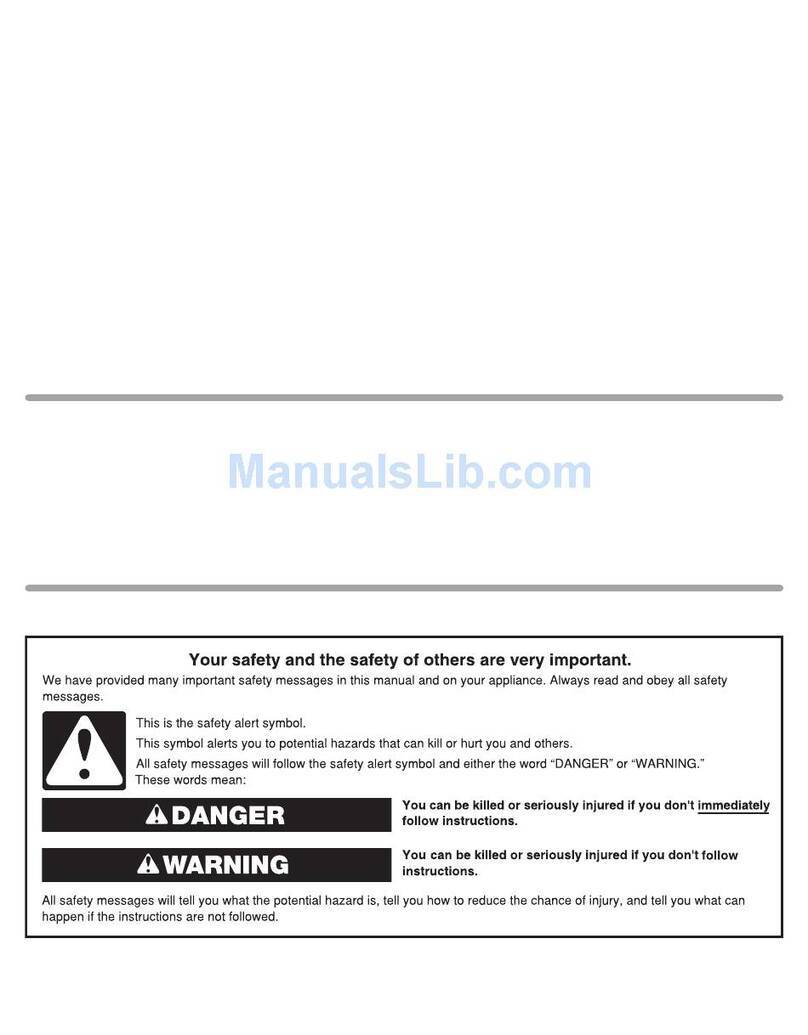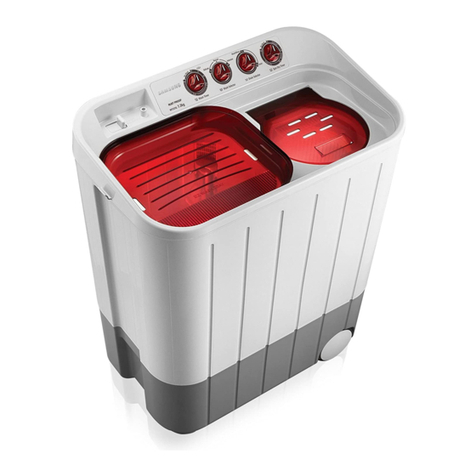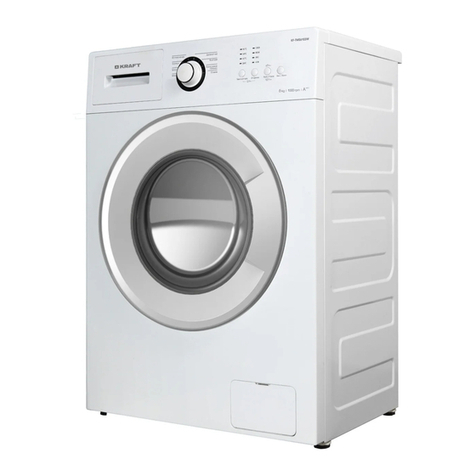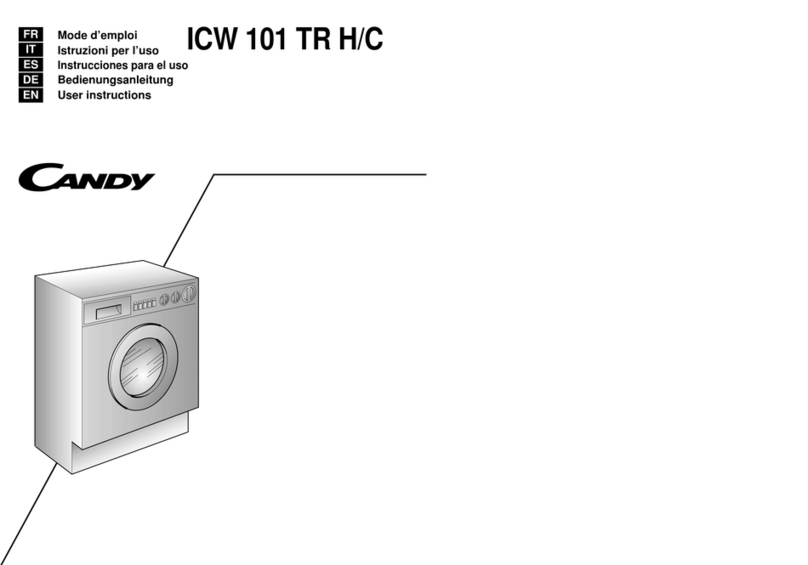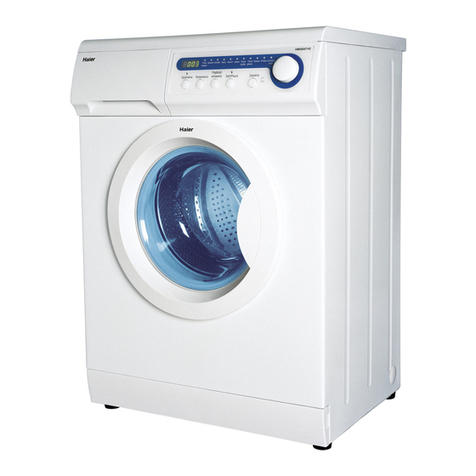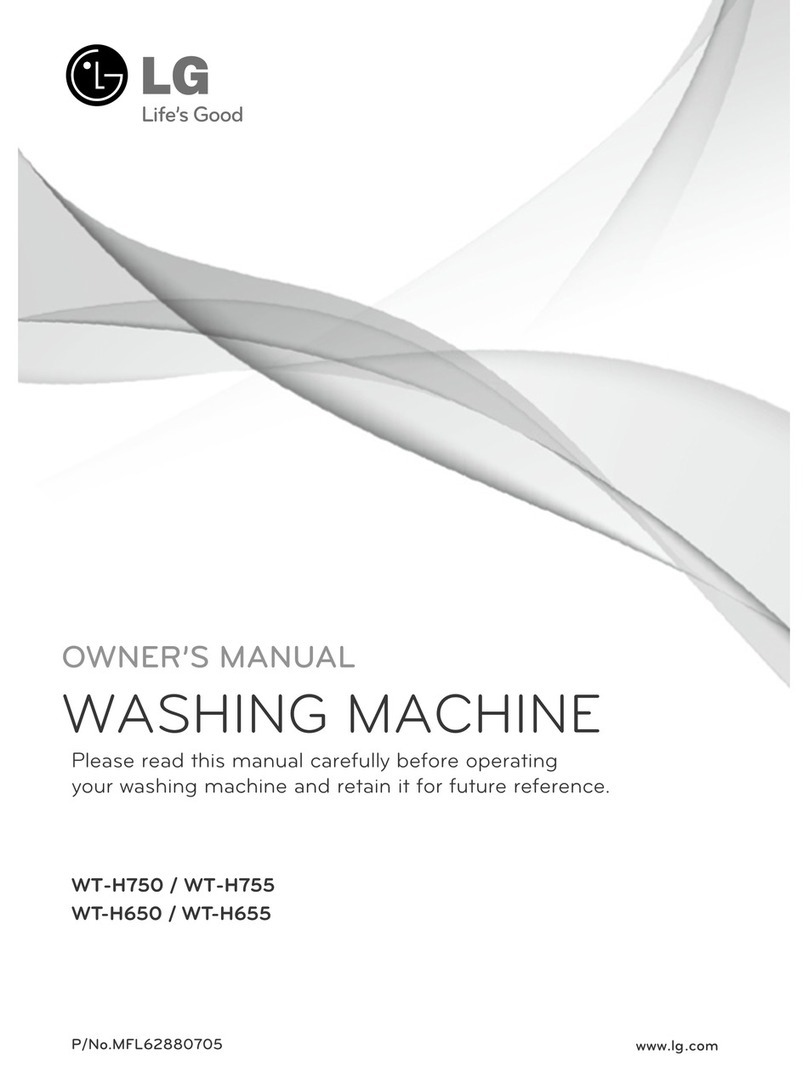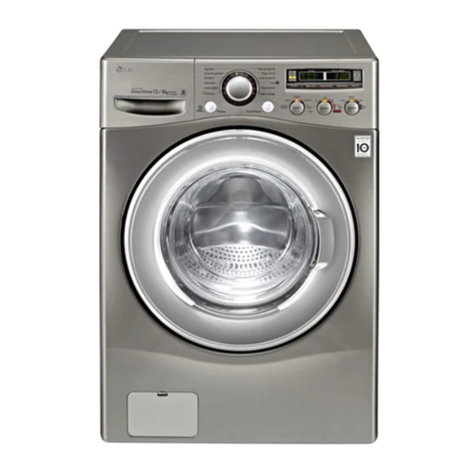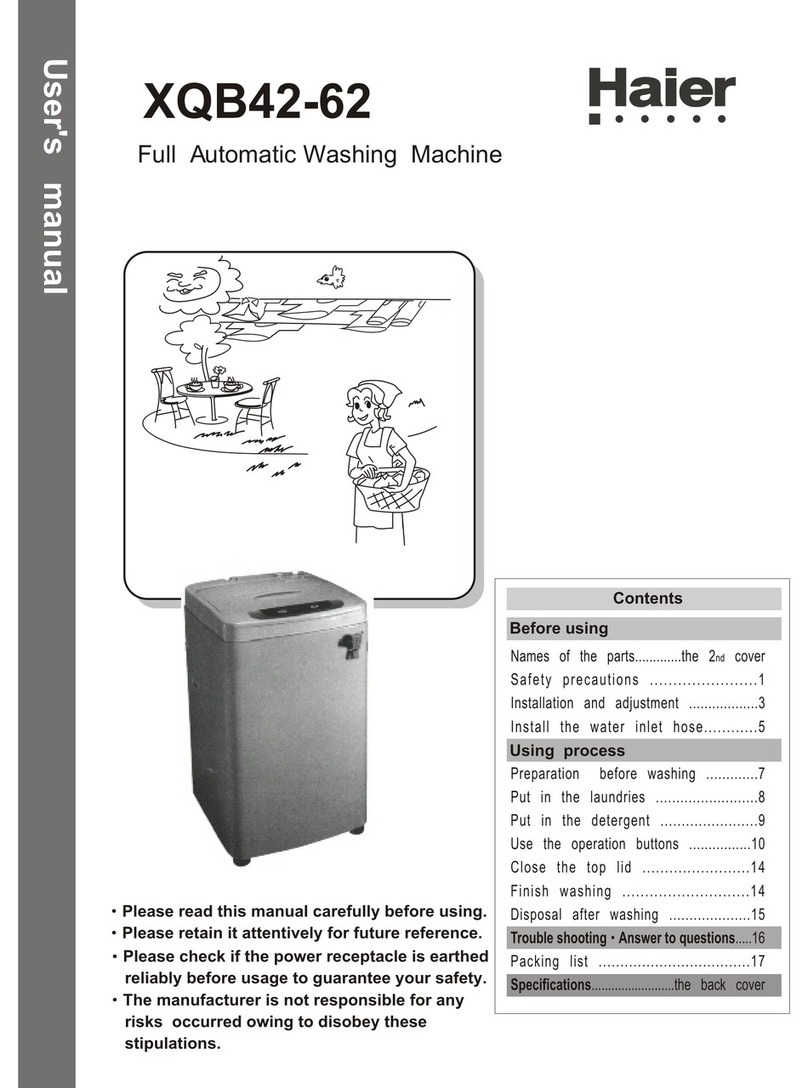Imesa LM65PEDP User manual

Operating Instructions
Washing Machine
Imesa LM65PEDP
Dear Imesa customer!
Welcome to the family of Imesa customers.
We hope that you will have many years of use from your new machine.
The machine has many features. To make the most of its functions, we
recommend that you read the operating instructions before using the
machine. The operating instructions include information on how you can
help protect the environment.
WARNING: Read the instructions before using the machine.

2
Contents
Before using your machine for the
first time 4
Transport protection 4
Packing material 4
Washer door 4
Language selection 4
Checking water hardness 4
Safety instructions 5
General 5
Installation 6
Overflow guard function 6
Transport/Winter storage 6
Recycling 6
Child safety 7
Keep an eye on children! 7
Description of the washing machine 8
Dispenser 9
Advice and tips before washing 10
Sorting your laundry 10
Clothing 10
Laundry labels 10
Hot water connection 10
Coloured cotton 10
Unbleached linen 10
Wool 10
Rayon fibres and synthetic fibres 10
Detergents 10
Washing 12
Sort your laundry. 12
Turn on the main power switch 12
Open the washer door and load the
washing 12
Add detergent and fabric softener,
as required 12
Select the programme 13
Close the washer door and press the
Start button 16
During the programme 16
Once the program has finished 16
Settings 17
You can change the following settings: 17
Language 17
Temperature 17
Water intake 17
Child-safe 17
Care and cleaning 18
Cleaning the trap and the drainage
pump 18
Cleaning the detergent compartment 18
Cleaning the outside of the machine 18
Rinse holes under the agitator 20
If you have hard water 20
Troubleshooting 21
The washer door will not open 21
Opening the door in an emergency 21
Original Instructions

3
Contents
The machine will not start 21
After power failure 21
Wet washing still in the machine 21
Error messages 22
Over flow fault 22
Information for test institute 23
Energy labelling 23
Technical data 23
Transport protection 24
Installation 25
Positioning the washing machine 25
Adjusting the feet 25
Connection to water supply 25
Drainage connection 26
Electrical installation 26
Service 27
Before contacting the service division 27
Quick guide 28

4
Transport protection
Remove any transport protection devices before
installing the machine. See the "Transport
protection" chapter.
Packing material
Please sort waste materials in accordance with
local guidelines.
Washer door
• The machine cannot be started when the
door is open.
• To open the washer door while a programme
is running, see "Close the door and press the
Start button" in the "Washing" chapter.
Language selection
You will be prompted to select the display
language when you have connected your
machine and start it for the first time. Do as
follows:
1. Turn the programme selector to choose from:
US English, English, Svenska, Dansk, Norsk,
Suomi, Français, Deutsch, Italiano, Espanol,
Русский, Nederlands.
2. Press Start once to save the setting.
Checking water hardness
The quantity of detergent needed depends,
amongst other things, on how hard the water
is. See the detergent pack for details. Phone
your local water company to check the water
hardness in your area.
NOTE!
Each machine is tested before leaving the
factory.
A small amount of water may remain in the drain
pump, though this does not affect quality or
damage the machine.
Before using your machine for the first time
See Quick guide on the last page

5
General
• Read the operating instructions and
keep them in a safe place.
• Installation of water and electricity, if
required, should be carried out by a
qualified professional.
• The machine should only be used for
washing items as described in these
instructions. It is not intended for dry
cleaning.
• Use only detergent intended for
machine washing!
• Do not use detergents that contain
solvents as this could lead to release
of poisonous gases, damage to
the machine, and risk of fire and
explosion.
• Do not use colourants (dyes) or
bleaching substances (substances
for discolouration or removal of
colourants) as they contain sulphuric
compounds that could cause
corrosion.
• Excessive use of products containing
chlorine compounds increases the
risk or premature failure of appliance
components. This depends on the
concentration of chlorine, exposure
time, and temperature.
• Bleaches that contain chlorine can
be replaced with oxygen-based
bleaches. Otherwise, a neutralization
cycle should be performed by running
the Cotton program at the highest
temperature. For best results, use
hydrogen peroxide or oxygen-based
detergents.
• Remove any transport protection
devices before using the machine.
See the "Transport protection"
chapter.
• Repairs and maintenance relating to
safety or performance must be carried
out by a qualified professional.
• Damaged mains cables must only be
replaced by a qualified electrician.
• The machine is not designed to be
used by persons (even children)
that are physically or mentally
handicapped or lack experience
and knowledge. Such persons must
receive instruction in how to use the
machine from the person responsible
for their safety.
• Children must be watched to ensure
they do not play with the machine.
• The emergency door opening tool is
attached to the rear of the detergent
compartment. Remove the detergent
compartment from the machine and
remove the emergency door opening
tool.
Safety instructions

6
Installation
See the "Installation" chapter.
Overflow guard function
If the machine’s water level rises above
the normal level, the overflow guard
function begins to pump water out and
shuts offthe water intake. If the water
level has not dropped within 60 seconds,
the program is terminated.
Transport/Winter storage
If the machine is to be transported or
stored in unheated premises where the
temperature can fall below freezing, do
as follows:
• Empty the filter and the drainage
pump. See the "Care and cleaning"
chapter.
• Shut offthe water to the washing
machine, loosen the supply hose to
the intake valve and let the water run
out from the valve and hose.
• After emptying the pump, a small
amount of water may remain in the
machine. This does not affect quality
or damage the machine.
Recycling
This machine is manufactured and
labelled for recycling. In order to prevent
injuries, the machine must be made
unusable once the decision has been
taken to dispose of it. Contact your local
authority for information about where
and how your machine can be recycled
correctly.
Safety instructions

7
Child safety
Keep an eye on children!
• Always close the washer door and
start the programme immediately after
you have added detergent.
• Do not allow small children to use or
play with the washing machine.
• Store detergent and fabric softener
out of the reach of children.
Activate child safety catch
(for detergent compartment)
On the inside of the detergent
compartment is a child safety catch.
Activated child
safety catch
Inactivated child
safety catch
When the child safety catch is activated
you must press the release button to pull
out the detergent compartment.

8
Description of the washing machine
1. Main power switch
2. Dispenser
3. Programme panel
4. Serial number plate (on inside of washer
door)
5. Drainage pump cover
6. Drainage pump (behind cover)
7. Washer door
1
7
23 4
5,6

9
Dispenser
14
5
6
23
1. Pre-wash
2. Main wash with liquid detergent.
Use the separator (A).
3. Main wash with powder detergent.
Do not use the separator.
4. Fabric softener
5. Release button
6. Child safety catch
A
B
C

10
Advice and tips before washing
Here are some tips that may help you before
washing.
Sorting your laundry
Sort items according to:
• how soiled they are
• colour
• material
Clothing
1. Do up zips and close Velcro straps so that
they don’t harm fabrics.
2. New coloured items may contain excess dye
and should therefore be washed separately
the first few times.
3. Turn delicate items inside out. This reduces
the risk of burling and fading.
4. Empty pockets and wash them inside out if
possible.
Laundry labels
Look at the item's laundry label. The table below
shows suitable wash programmes for different
materials and wash loads. Using modern
washing machines and detergents, for example
compact detergents, you can usually wash at
lower temperatures. It is a good idea to use trial
and error to find out what produces the best
results.
Hot water connection
(depending on the model)
Hot water intake has a positive effect on grease
stains and certain pigment stains, such as oil,
soot and coffee. Note however that difficult
protein stains with albumen content (blood,
milk, meat and fish) first need to be soaked
in cold water as they are difficult to dissolve
at temperatures above 40 °C. For the best
washing results we recommend the Super wash
option and pre-soaking the stained items in cold
water before washing them in the machine.
Coloured cotton
Coloured cotton items with the washing
instruction 60 °C should be washed at 60 °C for
the first time in order to remove any excess dye.
If you do not do so, there is a risk that the colour
will run. Use detergent without bleach in order to
preserve the colour of the fabric.
Unbleached linen
Unbleached linen fabrics should be washed at
60 °C, using detergent containing no bleach
or optical whiteners. Heavily-soiled linen can
occasionally be washed at higher temperatures,
but not too often because the heat can destroy
the linen’s shine and strength.
Wool
These fabrics are labelled either machine wash
or hand wash. The Wool/hand wash, 30 °C
programme is at least as gentle as washing by
hand.
Rayon fibres and synthetic fibres
Materials made of rayon fibres, such as viscose,
and some synthetic fibres are very delicate and
require much space so as not to crease. Only
half fill the drum when washing and choose a
spin speed of 800 rpm or lower.
NOTE!
Viscose and acetates are fragile when wet.
Detergents
Eco-labelled detergents are less harmful to the
environment.
Detergent overdosing does not give better

11
washing results; it merely causes a greater
impact on the environment.
Try to use less detergent, and increase only if
you are not satisfied with the results.
NOTE!
Due to environmental concerns, we discourage
the use of strong chemicals.
When using agents for bleaching or stain
removal, there is a risk of rust (corrosion) and
discolouration of the machine.
Advice and tips before washing

12
Washing
1Sort your laundry.
See the "Advice and tips before washing"
chapter.
Place underwired bras in a laundry net.
Empty pockets. Coins, nails and the like can
cause damage to the machine and fabrics. See
the "Advice and Tips" section before washing.
2Turn on the main power switch
3Open the washer door and load
the washing
Open the washing machine door. Load
the washing. The wash programme chart shows
how much washing can be washed with each
programme.
4Add detergent and fabric
softener, as required
The detergent packaging will have
recommendations for how much detergent you
should use. The machine holds 8 kg of washing.
If you only have a small amount of laundry in
the machine, you can reduce the amount of
detergent used.
Follow the manufacturers' recommendations as
regards which type of detergent is suitable for
which temperature.
Powder detergent
Pour the powder into the compartment for the
main wash, and pre-wash as well if desired.
Liquid detergent
When using a liquid detergent, observe the
detergent manufacturer's recommendations.
We recommend using a laundry ball with thick
detergents. In the main detergent compartment,
use the section wall (A) – see figure in the
section Dispenser. Add the detergent into the
front compartment of the detergent dispenser.
Wash ball or net
If you use a wash ball or net, place it directly in
the drum and select a programme without pre-
wash.
NOTE!
Detergent overdosing does not give better
washing results; it merely causes a greater
impact on the environment.
Try using less detergent, and increase only if
you are not satisfied with the results.
Fabric softener
Pour the fabric softener into the
compartment with the symbol. Follow
the recommendations on the fabric softener
packaging.
NOTE!
Do not fill above the compartment’s maximum
fill level. Otherwise fabric softener will run in too
early, which impairs the washing effect.

13
Washing
The display shows the programme name, the
water temperature and the spin speed.
The washing machine has a number of
preselected programmes when delivered from
the factory. The preselected programmes can
be replaced. Contact the service division for
information on which programmes are available
and how to alter the preselected programmes.
White, 90 °C
Programme for normally to heavily soiled
laundry. Follow the washing instructions for
each garment. 90 °C is a good temperature for
white and light-coloured cotton, such as bed
linen.
White/Colour, 60 °C
Programme for normally soiled laundry, whites
and colours. Follow the washing instructions for
each garment. 60 °C is a good temperature for
garments worn next to the skin.
White/Colour, 40 °C
Programme for normally soiled laundry, whites
and colours. Follow the washing instructions for
each garment.
Super quick wash, 60 °C
Fast programme for laundry that just needs
freshening up. Follow the washing instructions
for each garment. Garments worn next to the
skin ought to be washed at 60 °C.
Super quick wash, 40 °C
Fast programme for laundry that just needs
freshening up. Follow the washing instructions
for each garment.
Synthetics, 40 °C
Programme for synthetics, delicate blended
materials and permanent press cotton. Suitable
for shirts and blouses. Follow the washing
instructions for each garment. Many synthetics
will come clean at 40 °C.
Wool/hand wash, 30 °C
A gentle laundry programme for wool, silk and
garments that should be washed by hand. This
programme has a short spin.
Rinse
This programme performs one cold rinse cycle
+ spin. Suitable for laundry that just needs to be
dampened.
5
Select the programme
Programme selector Time remaining
Main power switch Program Stop
Start

14
Washing
Programme chart
Program
Prewash
Temp. °C
Number of Rinses
Spin Speed rpm
Max. load (kg)
Water consumption
(approx. liter)
Energy
consumption
(approx. kWh)
Programme time
(approx. hrs and
min.)
Hot 1) Cold 2) Sum 1)+2)
Standard cotton 60 3 1200 8 24 46 70 1,30 3:10
Standard cotton 40 3 1200 8 24 46 70 0,70 3:00
Heavy wash X 90 3 1200 8 9 69 78 2,55 2:00
Heavy wash X 60 3 1200 8 9 62 71 1,40 1:35
White 90 3 1200 8 20 44 64 2,30 1:45
White / Colour 60 3 1200 8 20 37 57 1,40 1:25
White / Colour 40 3 1200 8 20 37 57 0,60 1:05
Super quick wash 60 3 800 4 15 28 43 0,90 0:40
Super quick wash 40 3 800 4 15 28 43 0,50 0:40
Synthetics 40 3 800 4 12 30 42 0,40 0:40
Wool/Hand wash 30 3 800 3 60 60 0,30 0:40
Rinse 1 1200 4 15 15 0,10 0:15
MOP wash X 90 2 1200 8 20 42 62 2,40 1:35
MOP wash X 60 2 1200 8 20 35 55 1,40 1:15
Micro fibre 60 3 1200 8 19 31 50 1,10 1:10
Micro fibre 40 3 1200 8 19 31 50 0,40 0:55
Disinfection X 90 2 1200 8 24 50 74 2,70 2:00
Disinfection X 60 3 1200 8 24 39 63 2,10 2:30
Disinfection X 40 3 1200 8 24 39 63 1,00 1:35
Allergy cotton 90 6 1200 8 22 59 81 2,70 3:05
Allergy cotton 60 6 1200 8 22 52 74 1,60 2:40
Allergy cotton 40 6 1200 8 22 52 74 1,10 2:20
Allergy synthetics 60 6 1200 4 13 61 74 1,00 2:05
Allergy synthetics 40 6 1200 4 13 61 74 0,60 1:55
Cleaning 90 3 1200 / 22 66 88 2,40 1:30
Program A
Program B
Program C
1) Connection to Hot water, approx. 55 °C.
2) Connection to Cold water, approx. 15 °C.
The above table presents a few examples of the energy, water and time consumption of a few different programme settings. Consumption can vary
depending on water pressure, water hardness, water supply temperature, room temperature, load weight and content, variations in the power supply and
selected options.

15
Washing
Adjustment of the displayed washing time
Advanced technology allows the appliance
to sense the amount of laundry and add the
required amount of water during the washing
process. Depending on the washing load,
washing time can be longer or shorter and the
time displayed will be adjusted accordingly.
Moreover, displayed washing time may change
due to differences in inlet water temperature.
At low inlet water temperatures, washing time
can be longer; at higher temperatures, it can be
shorter.
Unevenly distributed laundry or lumps of
laundry in the washing machine drum can cause
problems such as vibration and noisy operation.
The appliance can sense such lumps and will
try to redistribute the laundry. Smaller loads
(e.g. one towel, one sweater, one bathrobe
etc.) or clothes made of materials with special
geometrical properties are virtually impossible
to distribute evenly across the washing machine
drum (slippers, large items etc.). This results
in several attempts to redistribute the laundry,
which in turn leads to longer program duration.

16
Washing
6Close the washer door and
press the Start button
NOTE!
A few seconds after you start a programme the
washing machine will begin to fill with water
from both the hot and the cold supplies. If for
some reason no hot water is available, the
machine waits for one minute and then fills with
cold water only. The wash drum does not start
to rotate until it begins to fill with water.
The hot water inlet is only open for washing
programs with water temperature of 40 °C or
higher.
During the programme
Time remaining
“Programme started” is shown on the display.
Stopping or changing a programme
You can stop a programme by pressing the Stop
button for three seconds. ”Stop” appears in the
display. To restart the machine, select a new
programme, add any extra detergent needed
and press the Start button.
NOTE!
Do not open the detergent compartment while
the machine is running.
7Once the program has finished
The text "Done" is shown on the display
for 10 minutes. The machine then turns
off.
Once the program is finished, the washer door
will automatically unlock.
• Open the door and remove the laundry.
If you have small children or pets at home, close
the washer door once you have removed the
laundry.
NOTE!
Upon completion of the washing cycle, close the
water faucet and unplug the mains cord.

17
Settings
You can change the following
settings:
• Language
• Temperature °C/°F
• Water intake
• Child-safe
Do as follows to open the settings menu:
1. Turn offthe machine using the main power
switch.
2. Press and hold the Stop button and then
press the main power switch. Then press the
Stop button 5 times within 10 seconds.
3. Select the setting you want to change by
turning the programme selector.
4. Press the Stop button once.
5. Change and save the setting as described
below.
6. Press Start to return to the programme menu.
Language
1. Turn the programme selector to choose from:
US English, English, Svenska, Dansk, Norsk,
Suomi, Français, Deutsch, Italiano, Espanol,
Русский, Nederlands.
2. Press the Stop button once to save the
setting.
Temperature
1. Turn the programme selector to choose
between: °C and °F.
2. Press the Stop button once to save the
setting.
Water intake
(depending on the model)
Connecting to both the hot and cold water
supplies reduces the wash time and reduces
the washing machine's electricity consumption.
At the factory, the machine is set for connecting
to both hot and cold water supplies. Select Cold
if you want to set the machine for cold water
intake only.
• Turn the programme selector to choose
between: Cold and Hot.
• Press the Stop button once to save the
setting.
Child-safe
You can activate the Child-safe start option to
prevent children from starting the machine.
1. Turn the programme selector and select
"Child-safe On" or "Child-safe Off".
2. Press the Stop button once to save the
setting.
You can temporarily deactivate Child-safe start
by pressing Start and the Stop button at the
same time. Child-safe start will be deactivated
for 3 minutes.

18
Cleaning the trap and the drainage
pump
The washing machine has a trap where smaller
objects such as coins and hairpins can collect.
To clean the trap and the drainage pump, do as
follows:
1. Make sure the machine is empty of water
and switched offat the mains.
2. Open the door.
3. Unhook the drainage hose from the
connector inside the door and drain the water
into a suitable container, such as a shallow
bowl.
4. Turn the cover anti-clockwise to open the
pump. Remove the cover.
5. Remove any items and so forth from the
pump housing and the cover. Also check that
the pump blades right at the back rotate.
6. Screw on the cover, replace the drainage
hose on the hatch pin and close the hatch.
Cleaning the detergent compartment
Pull out the detergent compartment using the
release button.
Rinse the compartment and scrub it clean. The
cover in the fabric softener compartment can be
removed.
NOTE!
Do not run the detergent compartment through
a dishwasher!
Cleaning the outside of the machine
Clean the outside of the machine and the
program panel with a mild cleaner. Do not
use any solvents, as these can damage the
machine.
NOTE!
Do not hose down the machine with water!
Care and cleaning

19
Care and cleaning
Cleaning the inside of the machine to
avoid unpleasant smells
Modern detergents often allow clothes to be
washed at low temperatures. This means that
small deposits can build up in the machine.
These, in turn, may lead to unpleasant smells
developing.
To avoid this, we recommend running a 90 °C
wash programme once a month. When you do
this, use a small quantity of detergent. It is not
necessary to put any washing in the machine.

20
Rinse holes under the agitator
If you suspect that objects such as nails or
paper clips may have fallen into the wash
drum, you should check the space under the
agitator. Such objects can rust and cause spots
on clothing. Nails and other sharp objects can
cause holes in fabrics.
Do as follows:
1. Insert a screwdriver or the like into the hole
on the agitator as illustrated and carefully pry
to the left.
2. Use your other hand to grasp the agitator and
pull it towards you.
3. Lift the agitator.
4. Remove any objects.
5. Place the agitator in the mounting hole with
the F-mark towards you. Ensure that all the
agitator fasteners are in their holes in the
drum. Push it in until it catches.
If you have hard water
If you live in an area with hard water (high
limescale content), a greyish-white coating may
form on the wash drum. To remove this coating,
pour approximately 20 gram of citric acid into
the wash drum and run any 90 °C programme.
Repeat if necessary.
Table of contents
Other Imesa Washer manuals



